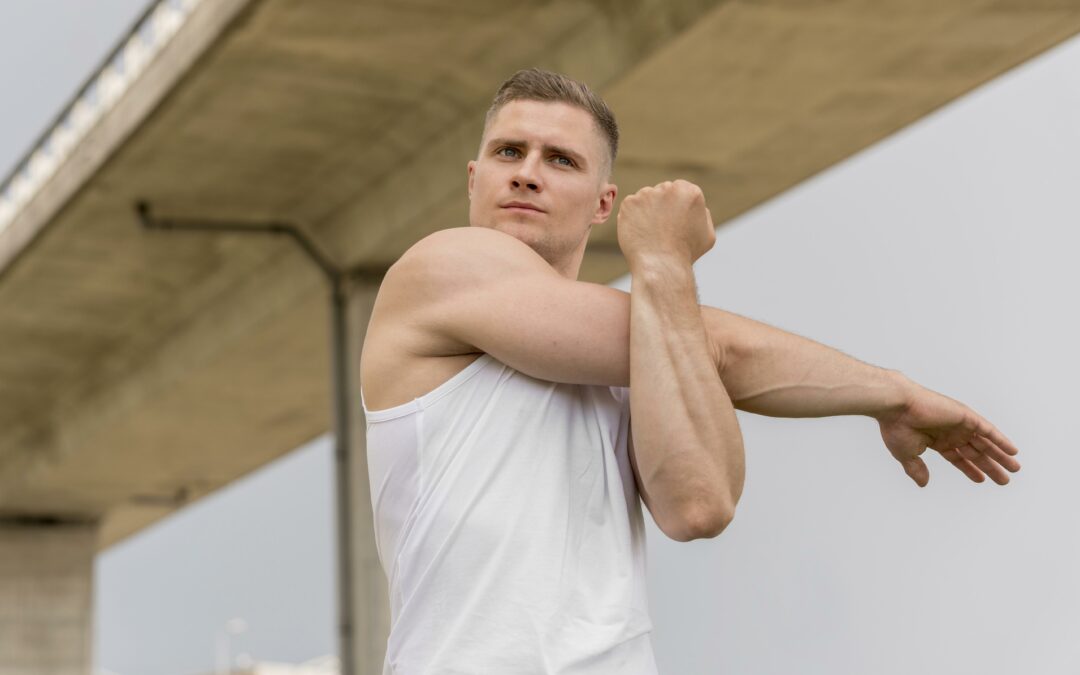The rotator cuff is comprised of four tendons and a tear in anyone of them can limit a person’s range of motion in a variety of ways. If you have a torn rotator cuff, gentle exercises can help improve strength, flexibility, and stability in the shoulder. However, it’s important to proceed carefully, especially if the tear is significant. Even if you don’t have a tear and you are getting older performing these exercises a few times per week will help bulletproof your shoulder. The rotator cuff is a small tendon but even a small tear can put the kibosh to any resistance training program so don’t neglect corrective exercises. Here are some exercises that are generally safe, but you should consult with a doctor or physical therapist before starting them:
- Pendulum Swing
- How to do it:Lean forward, supporting yourself with your unaffected arm on a table or chair. Let your injured arm hang down, and gently swing it in small circles for 30 seconds.
- Reps:1-3 sets, daily.
- Benefits:Relieves pressure and gently mobilizes the shoulder.
- Towel Stretch
- How to do it:Hold a towel behind your back with both hands, with the affected arm below. Use your other arm to gently pull the towel upward, stretching the injured shoulder.
- Duration:Hold for 15-30 seconds.
- Reps:3-4 times.
- Benefits:Increases shoulder flexibility, especially for internal rotation.
- Crossover Arm Stretch
- How to do it:Bring your injured arm across your body at shoulder level and gently pull it closer to your chest with your opposite hand.
- Duration:Hold for 15-30 seconds.
- Reps:3-4 times.
- Benefits:Stretches the shoulder muscles and helps improve range of motion.
- External Rotation with Resistance Band
- How to do it:Attach a resistance band to a secure object at waist height. Hold the band with your affected arm at a 90-degree angle at your side, keeping your elbow tucked in. Slowly rotate your arm outward, keeping your elbow against your body, then return to the starting position.
- Reps:10-15 reps, 2-3 sets.
- Benefits:Strengthens the rotator cuff muscles, especially the infraspinatus and teres minor.
- Internal Rotation with Resistance Band
- How to do it:Attach a resistance band to a secure object, this time on the opposite side of your body. Hold the band with your affected arm bent at a 90-degree angle. Pull the band across your body, keeping your elbow close to your torso, and then return to the starting position.
- Reps:10-15 reps, 2-3 sets.
- Benefits:Strengthens the subscapularis muscle, which is part of the rotator cuff.
- Scapular Retraction (Shoulder Blade Squeezes)
- How to do it:Sit or stand with good posture. Squeeze your shoulder blades together and hold for a few seconds, then release.
- Reps:10-15 reps, 2-3 sets.
- Benefits:Improves posture and strengthens the muscles around the shoulder blade, reducing stress on the rotator cuff.
- Isometric Shoulder External Rotation
- How to do it:Stand against a wall with your elbow bent at a 90-degree angle, close to your body. Press the back of your hand against the wall without moving your arm. Hold for a few seconds, then release.
- Reps:10 reps, 2-3 sets.
- Benefits:Builds strength in the shoulder without joint movement, reducing strain.
- Shoulder Flexion
- How to do it:Stand or sit with your arm at your side. Lift your arm in front of you to shoulder height, keeping it straight. Lower it slowly.
- Reps:10-15 reps, 2-3 sets.
- Benefits:Strengthens the front of the shoulder and promotes controlled movement.
Tips for Success:
- Start with small ranges of motionand low resistance.
- Use heat or iceafter exercises if there’s discomfort.
- Stay consistentand go slowly to avoid re-injury.
Eight different exercises may seem like a lot and in reality it is. My recommendation here is to pick two exercises and do them 2 times per week and rotate the exercises weekly. At the end of the month you will have completed all 8. Remember with corrective or rehab exercises consistency is the key. If any exercise causes sharp pain, stop and consult a professional.
What Is the Longevity Course? This all-encompassing program is designed to provide you with the knowledge, tools, and strategies needed to maximize your lifespan and enhance your quality of life. Whether you aim to improve your fitness, master your nutrition, optimize your sleep, balance your hormones, manage your blood sugar levels, or even explore medicinal interventions, The Longevity Course is tailored to support you on this transformative journey.

